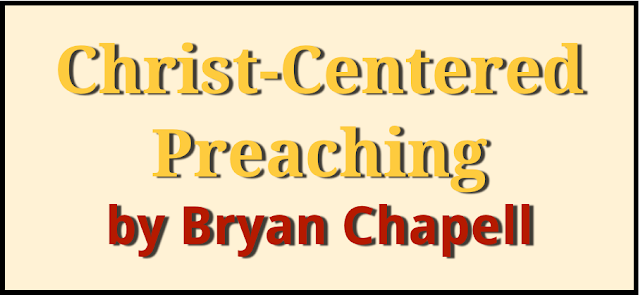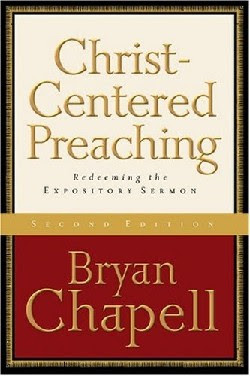4.5 out of 5 Stars
Author: Bryan Chapell
Publisher: Baker Academic
Buy Christ-Centered Preaching
Reading Level: Easy
Christ-Centered Preaching will help all those seeking to study and organize their sermon preparations will focusing stringently on being Christ-centered. Chapell divides the book up into four parts--
A term which is critical to understanding what Chapell means by Christ-centered preaching is the Fallen Condition Focus.
In part 2, Chapell discusses the practical matters of sermon preparation. He emphasizes over and over again that no amount of preparation will make for the Spirit's unction and power, but that the Spirit typically works through our preparation. Furthermore,
Chapell in chapter 5 discusses “Six Critical Questions” we should ask.
Chapell denies the idea the sermons should not have any illustration, but does insist that illustration be relevant and meaningful.
He then explains the importance of application, introductions, and conclusions. With application, he recommends asking simple journalistic questions (214).
He introduces “The Introduction Chain”--1) arouse interest, 2) introduce subject, 3) make it personal, 4) bond to Scripture, & 5) attach proposition. With conclusions, says Chapell,
In part 3, Chapell ends by discussing the redemptive approach to preaching. In every text, he encourages preachers to apply the redemptive work of Christ to the hearers. He warns, however,
In the appendixes, Chapell wraps up all the loose ends discussing delivery, dress, speaking styles, and sermons for all occasions. One strength of the book as a whole was Chapell's use of a myriad of sources. I enjoyed reading quotations from Jay E. Adams, John Stott, Al Mohler, & John Broadus to name a few. He does well presenting the strengths of multiple preaching resources.
If you plan on purchasing Christ-Centered Preaching, consider supporting Grace for Sinners by purchasing from Amazon.
Author: Bryan Chapell
Publisher: Baker Academic
Buy Christ-Centered Preaching
Reading Level: Easy
Christ-Centered Preaching will help all those seeking to study and organize their sermon preparations will focusing stringently on being Christ-centered. Chapell divides the book up into four parts--
- Part 1 Principles for Expository Preaching
- Part 2 Preparation of Expository Preaching
- Part 3 A Theology of Christ-Centered Preaching
- Appendixes
These priorities indicate that the goal of preaching is not merely to impart information but to provide the means of transformation ordained by a sovereign God that will affect the lives and destinies of eternal souls committed to a preacher's spiritual care (25).So preaching is not merely discussing the facts in a text accurately, but demonstrating how these facts can transform someone from death unto life. He rightly highlights the importance of the preacher's character. We should all ask the question: Does my character support what I am preaching?
A term which is critical to understanding what Chapell means by Christ-centered preaching is the Fallen Condition Focus.
An FCF determines the real subject of a message by revealing the Holy Spirit's purpose(s) in inspiring a passage. Ultimately, a sermon about how a text says we are to respond biblically to the FCF as it is experienced in our lives--identifying the gracious means that God provides for us to deal with the human brokenness that deprives us of the full experience and expression of his glory (50-51).His concern with the FCF of every passage really under-grids part 1 and the entire book.
In part 2, Chapell discusses the practical matters of sermon preparation. He emphasizes over and over again that no amount of preparation will make for the Spirit's unction and power, but that the Spirit typically works through our preparation. Furthermore,
the conviction that people are spiritually transformed only through personal confrontation with the truths of the Word of God complicates the task of preaching (103).
Chapell in chapter 5 discusses “Six Critical Questions” we should ask.
- What does the text mean?
- How do I know what the text means?
- What concerns caused the text to be written?
- What do we share in common with those to (or about) whom the text was written and/or the one by whom the text was written?
- How should people now respond to the truths of the text?
- What is the most effective way I can communicate the meaning of the text?
Chapell denies the idea the sermons should not have any illustration, but does insist that illustration be relevant and meaningful.
Illustrations are stories whose details (whether explicitly told or imaginatively elicited) allow listeners to identify with an experience that further elaborates, develops, and/or discloses the explanation of scriptural principles (176).So illustrations are even expository in a sense because they must interact faithfully with the point of the text.
He then explains the importance of application, introductions, and conclusions. With application, he recommends asking simple journalistic questions (214).
- What does God now require of me? (Instructional Specificity)
- Where does he require it of me? (Situational Specificity)
- Why must I do what he requires? (Motivation)
- How can I do what God requires? (Enablement)
In the introduction you must enter their world and persuade them to go with you into the world of biblical truth, and specifically the truth that is the burden of the sermon (238).
He introduces “The Introduction Chain”--1) arouse interest, 2) introduce subject, 3) make it personal, 4) bond to Scripture, & 5) attach proposition. With conclusions, says Chapell,
G. Campbell Morgan said, “Every conclusion must conclude, include, and preclude.” To conclude, a conclusion must truly end a message. To do this well, it must include what was previously said and preclude the possibility that the implications and the consequences of the message will escape the listener (254).He also cautions against adding to material or interpretations during the conclusion. The sermon should be climaxed.
In part 3, Chapell ends by discussing the redemptive approach to preaching. In every text, he encourages preachers to apply the redemptive work of Christ to the hearers. He warns, however,
Christ-centered preaching rightly understood does not seek to discover where Christ is mentioned in every text but to discover where every text stands in relation to Christ (279).Without this approach, preachers fall into the trap of mere moral exhortations devoid of the grace of God. He highlights these contextual features to highlight Christ's redemptive work.
- Predictive of the work of Christ
- Preparatory for the work of Christ
- Reflective of the work of Christ and/or
- Resultant of the work of Christ
In the appendixes, Chapell wraps up all the loose ends discussing delivery, dress, speaking styles, and sermons for all occasions. One strength of the book as a whole was Chapell's use of a myriad of sources. I enjoyed reading quotations from Jay E. Adams, John Stott, Al Mohler, & John Broadus to name a few. He does well presenting the strengths of multiple preaching resources.
If you plan on purchasing Christ-Centered Preaching, consider supporting Grace for Sinners by purchasing from Amazon.




No comments:
Post a Comment